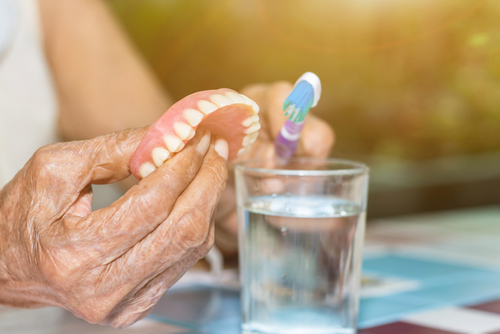Regain Your Smile & Confidence with Dentures in Tuckerton, NJ

Patients throughout Tuckerton, Little Egg Harbor, Manahawkin, and surrounding South Jersey communities trust Dr. Petrosky for his skill, gentle care, and dedication to long-term oral health. From your first consultation to final fitting, our goal is simple: to give you a smile you’re proud to wear. Contact our Tuckerton office today by calling (609) 296-1007 to achieve a smile you can be proud of.
Why Choose Tuckerton Dental for Dentures?
If you’re looking for the best dentist near you for dentures, Dr. Petrosky at Tuckerton Dental stands out for his skill, attention to detail, and compassion. With years of experience in restorative dentistry and a patient-first approach, Dr. Petrosky takes pride in transforming lives — one smile at a time.
One of our patients, Dan N. shared his experience:
- “Dr. Petrosky has the skills to enable me to have the confidence to smile again. He is compassionate and truly cares for his patients. He has been a skilled professional who changed my life for the better.”
We’re proud to serve our community in Tuckerton, NJ, and surrounding areas like Eagleswood, West Creek, Stafford Township, and Barnegat. Our welcoming team, advanced technology, and personalized care make us a top choice for smile restoration in South Jersey.
What Are Dentures?
Dentures are removable prosthetic devices that replace missing teeth and surrounding gum tissue. They’re custom-designed to fit your mouth and restore the function and appearance of your natural smile. Modern dentures are more advanced, comfortable, and lifelike than ever before — allowing you to eat, speak, and smile with ease.
There are different types of dentures to suit different needs:
- Full dentures replace all the teeth in the upper or lower jaw.
- Partial dentures fill in gaps when some natural teeth remain.
- Implant-supported dentures are anchored in place for extra security and stability.
- Immediate dentures can be placed right after extractions so you never go without teeth.
At Tuckerton Dental, every denture is custom-crafted to ensure a precise fit and a natural look. Whether you’re exploring dentures for the first time or ready for a comfortable, upgraded solution, Dr. Petrosky will guide you every step of the way with personalized care.
Benefits of Dentures
Many people are surprised to learn how life-changing dentures can be. Benefits include:
- Improved Appearance: Dentures restore the natural contours of your face and prevent the sunken appearance caused by tooth loss.
- Better Chewing & Digestion: With improved bite function, you can enjoy a broader, more nutritious diet.
- Clearer Speech: Missing teeth can affect pronunciation; dentures restore clarity in your speech.
- Boosted Confidence: Dentures help patients feel more comfortable in social settings, interviews, and everyday life.
- Custom Fit & Comfort: Our dentures are carefully crafted for a comfortable, secure fit using state-of-the-art materials.
The Denture Process at Tuckerton Dental
- Consultation & Exam: Dr. Petrosky evaluates your oral health and discusses your goals. X-rays or scans may be taken.
- Treatment Planning: We’ll determine the best denture type for you — whether full, partial, or implant-supported.
- Impressions: Detailed molds of your mouth are taken to design your custom dentures.
- Fitting & Adjustments: After your dentures are fabricated, you’ll come in for fittings. We’ll make precise adjustments for comfort and function.
- Follow-Up Care: We check in with you to ensure long-term satisfaction and make refinements as needed.
Every step is explained clearly, so you feel confident and supported.
Caring for Your Custom Dentures

- Clean daily: Remove and brush your dentures every day using a soft-bristled brush and denture-specific cleanser. Avoid regular toothpaste, which can be too abrasive.
- Soak overnight: Store your dentures in a soaking solution or plain water to keep them moist and maintain their shape. Never use hot water — it can warp the material.
- Rinse before wearing: Always rinse dentures before putting them back in, especially after soaking in a cleansing solution.
- Handle with care: Dentures are durable but can break if dropped. Clean them over a folded towel or a basin of water just in case.
- Visit us regularly: Schedule checkups with Dr. Petrosky to ensure your dentures still fit properly and to check your gums and oral tissues for changes.
With proper care and maintenance, your dentures can last for many years — and your smile will stay as bright and comfortable as the day you received them.
Cost of Dentures in Tuckerton, NJ
When considering dentures, one of the most common questions patients ask is about cost. The cost of dentures in Tuckerton can vary depending on several factors:
- Type of denture (full, partial, or implant-supported)
- Materials used for the denture base and teeth
- Whether tooth extractions or other treatments are needed
- If immediate dentures or relines are part of your plan
On average, traditional dentures can range from $1,000 to $3,000 per arch, while implant-supported dentures are a larger investment due to the added surgical component and enhanced longevity. At your consultation, our Tuckerton dentist will provide a clear, upfront estimate and walk you through your options.
We also accept a variety of dental insurance plans and offer financing options to help make your treatment as accessible as possible. Our team is here to help you maximize your benefits and restore your smile without unnecessary stress.
Frequently Asked Questions
The full process usually takes 4 to 6 weeks, depending on your dental needs and the type of denture. For immediate dentures, you’ll receive a temporary set the same day your teeth are extracted, with a permanent set placed after your gums heal.
Yes — but there’s an adjustment period. At first, soft foods are recommended as you get used to chewing with dentures. Speaking may also feel different for a few days, but with practice and proper fit, most patients adapt quickly and regain normal function.
Implant-supported dentures are anchored by titanium posts placed in the jawbone, offering superior stability, comfort, and bone preservation. They don’t shift or slip like traditional dentures and allow for a stronger bite force. They’re an ideal long-term solution for many patients.
Clean dentures daily using a soft-bristle brush and non-abrasive cleanser. Soak them in a denture solution overnight and rinse before wearing. Regular checkups with Dr. Petrosky help maintain their fit and monitor your oral health. Never use hot water or harsh chemicals, as they can warp the material.
Reclaim Comfort, Function, and Confidence with Dentures
At Tuckerton Dental, we believe no one should live without the ability to smile confidently or enjoy their favorite foods. Whether you’re just starting your tooth replacement journey or need to upgrade an existing denture, Dr. Ronald Petrosky, the best dentist in Tuckerton, NJ, is here to help you feel whole again. If you’re in Tuckerton, Little Egg Harbor, Manahawkin, or the nearby areas, don’t hesitate to contact Tuckerton Dental by calling (609) 296-1007.